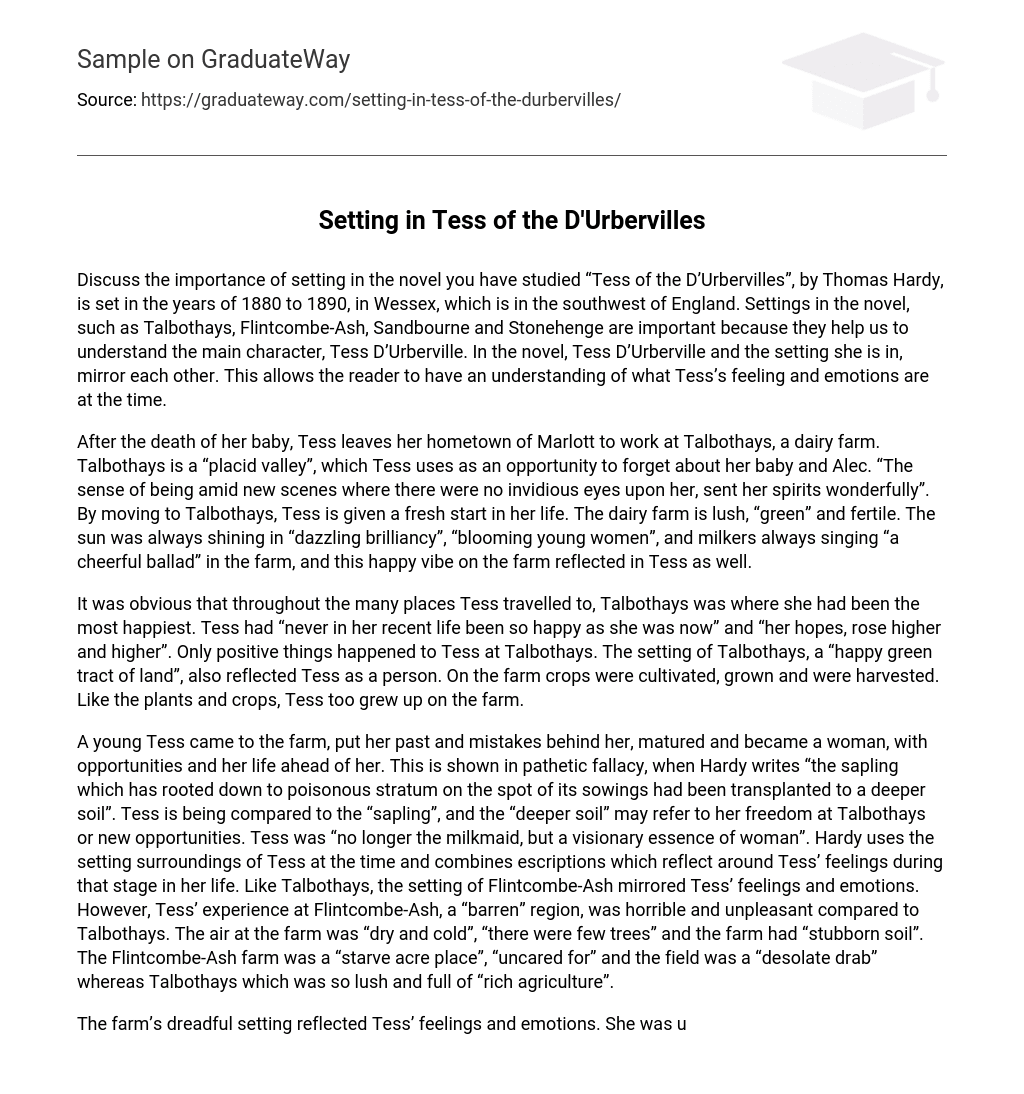Discuss the importance of setting in the novel you have studied “Tess of the D’Urbervilles”, by Thomas Hardy, is set in the years of 1880 to 1890, in Wessex, which is in the southwest of England. Settings in the novel, such as Talbothays, Flintcombe-Ash, Sandbourne and Stonehenge are important because they help us to understand the main character, Tess D’Urberville. In the novel, Tess D’Urberville and the setting she is in, mirror each other. This allows the reader to have an understanding of what Tess’s feeling and emotions are at the time.
After the death of her baby, Tess leaves her hometown of Marlott to work at Talbothays, a dairy farm. Talbothays is a “placid valley”, which Tess uses as an opportunity to forget about her baby and Alec. “The sense of being amid new scenes where there were no invidious eyes upon her, sent her spirits wonderfully”. By moving to Talbothays, Tess is given a fresh start in her life. The dairy farm is lush, “green” and fertile. The sun was always shining in “dazzling brilliancy”, “blooming young women”, and milkers always singing “a cheerful ballad” in the farm, and this happy vibe on the farm reflected in Tess as well.
It was obvious that throughout the many places Tess travelled to, Talbothays was where she had been the most happiest. Tess had “never in her recent life been so happy as she was now” and “her hopes, rose higher and higher”. Only positive things happened to Tess at Talbothays. The setting of Talbothays, a “happy green tract of land”, also reflected Tess as a person. On the farm crops were cultivated, grown and were harvested. Like the plants and crops, Tess too grew up on the farm.
A young Tess came to the farm, put her past and mistakes behind her, matured and became a woman, with opportunities and her life ahead of her. This is shown in pathetic fallacy, when Hardy writes “the sapling which has rooted down to poisonous stratum on the spot of its sowings had been transplanted to a deeper soil”. Tess is being compared to the “sapling”, and the “deeper soil” may refer to her freedom at Talbothays or new opportunities. Tess was “no longer the milkmaid, but a visionary essence of woman”. Hardy uses the setting surroundings of Tess at the time and combines escriptions which reflect around Tess’ feelings during that stage in her life. Like Talbothays, the setting of Flintcombe-Ash mirrored Tess’ feelings and emotions. However, Tess’ experience at Flintcombe-Ash, a “barren” region, was horrible and unpleasant compared to Talbothays. The air at the farm was “dry and cold”, “there were few trees” and the farm had “stubborn soil”. The Flintcombe-Ash farm was a “starve acre place”, “uncared for” and the field was a “desolate drab” whereas Talbothays which was so lush and full of “rich agriculture”.
The farm’s dreadful setting reflected Tess’ feelings and emotions. She was upset often and cried about her husband who had left her. As a worker at Flintcombe-Ash, Tess “has to serve” the “red tyrant” steam threshing machinery and turn the “inexorable wheels”. Tess “was so tired” from working “hour after hour”, where she worked like a servant, feeding the “despotic demand” of the machinery. Flintcombe-Ash reflected the harshness of the work and the desolation of Tess’ life. Only negative things happened to Tess during her work experience at Flintcombe-Ash.





